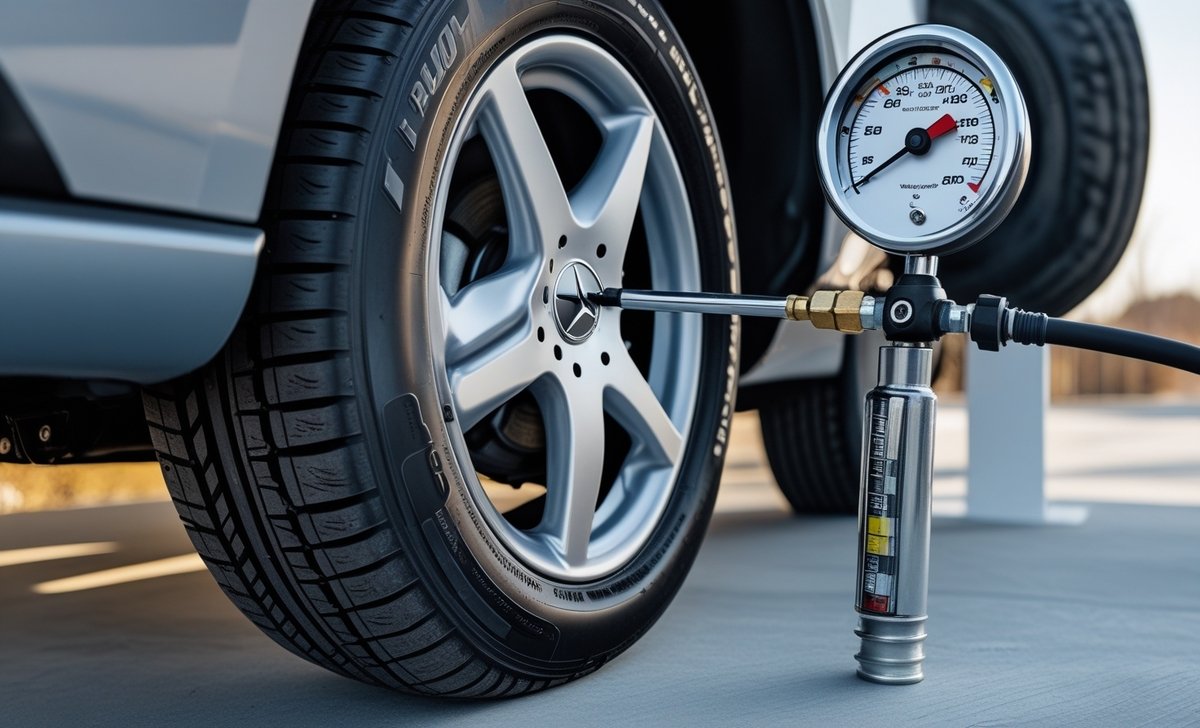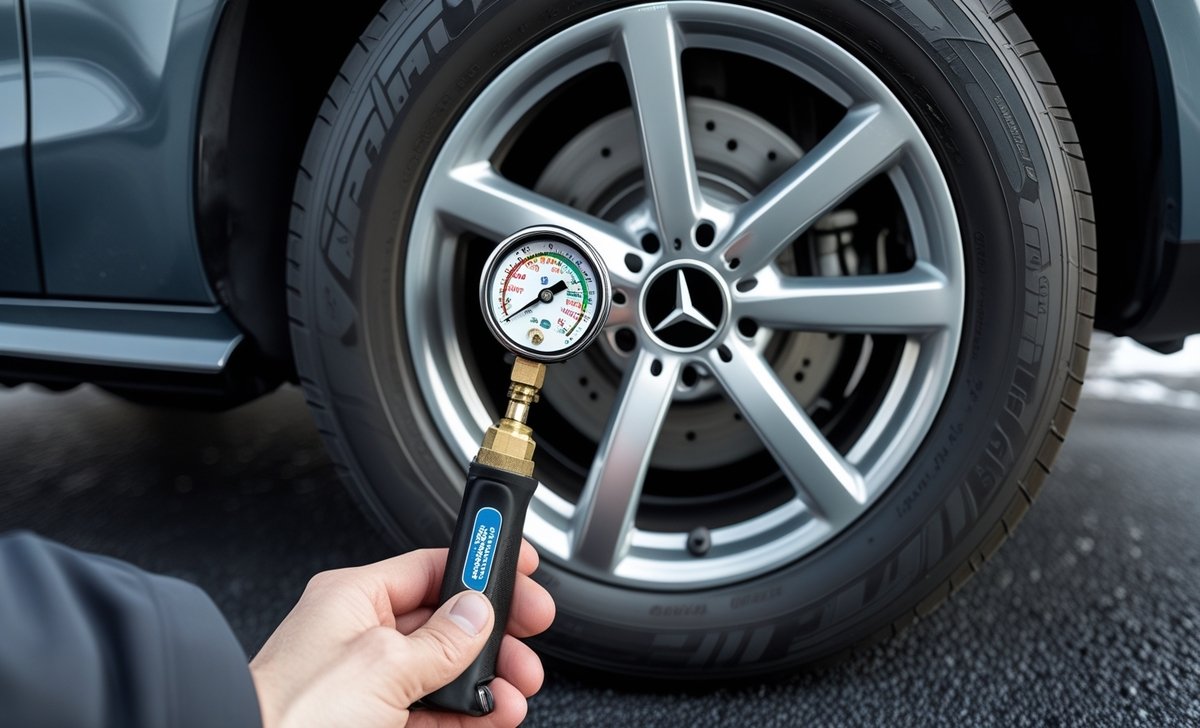A C300 Mercedes runs optimally if you ensure it involves more than just checking the engine. Tire pressure plays a significant role in your vehicle’s performance and safety.
Mercedes-Benz vehicles come equipped with a Tire Pressure Monitoring System (TPMS), which alerts the driver when a tire’s pressure falls below a certain threshold (usually 25% lower than the recommended pressure). This system is a safety feature designed to reduce the risk of accidents due to under-inflated tires.
Tire pressure can fluctuate due to weather conditions. For every 10°F drop in temperature, tire pressure can decrease by about 1-2 PSI. Let’s see how to check and maintain the C300 Mercedes tire pressure and why it’s important for performance, safety, and tire life.

What Do You Know About Correct Tire Pressure?

Maintaining the right air pressure in your tires is crucial to ensure the longevity and safety of your Mercedes C300. Incorrect tire pressure can lead to poor handling, increased fuel consumption, and excessive tire wear.
Your Mercedes-Benz tire pressure monitoring system (TPMS) alerts you when the tire pressure light turns on. This light indicates that one or more of your tires are underinflated.
When you check the tire pressure, it’s important to use the recommended tire pressure listed in your vehicle’s owner manual or on the sticker located inside the fuel door.
For most Mercedes C300 models, the ideal pressure typically ranges between 32 to 35 PSI for standard driving conditions. However, different types of tires, such as performance tires, summer tires, and winter tires may have different recommendations.
C300 Mercedes Tire Pressure For Different Tire Types

- Summer Tires: Summer tires typically require slightly higher pressure, around 33-36 PSI for both front and rear.
- Winter Tires: Winter tires are designed for colder weather. Their recommended tire pressures are generally similar to those of all-season tires. However, you should check the tire pressure regularly. Cold temperatures can cause the pressure to decrease more rapidly.
- All-Season Tires: These tires tend to have a recommended range of 32-35 PSI, with the most common pressure being around 34 PSI for both front and rear tires.
- Performance Tires: For performance tires on Mercedes-Benz models, a higher PSI may be recommended, typically around 36-38 PSI, to ensure optimum handling.
How To Check Tire Pressure In Your Mercedes-Benz C300

Mercedes-Benz vehicles come equipped with a TPMS, which alerts the driver when a tire’s pressure falls below a certain threshold (usually 25% lower than the recommended pressure). This system is a safety feature that reduces the risk of accidents due to underinflated tires. Checking and maintaining your tire pressure is easy with the right tools.
Here’s a step-by-step guide:
1.Get A Tire Pressure Gauge:

You can purchase a manual or digital tire pressure gauge from your Mercedes-Benz dealership or local auto parts store. We recommend a digital gauge for accuracy if you don’t already have one.
2. Check Tire Pressure When Tires Are Cold:

The best time to check your tire pressure is in the morning before you drive your car. Air pressure rises as you drive, so checking when the tires are cold ensures an accurate reading.
3.Locate The Valve Stem:

This is where you will insert your tire pressure gauge. The valve stem is usually located on the sidewall of each tire.
4. Insert The Gauge:
Firmly press the gauge onto the valve stem to get a reading. The gauge will give you the PSI of your tire.
5. Compare With Recommended Tire Pressure:

Compare the reading with the recommended tire pressure for your Mercedes C300 (usually between 32 to 35 PSI). If the tire pressure is too low or high, adjust it using an air compressor or visit a service center.
6. Fill Tires If Necessary:

If your tire is low, use an air compressor to fill it up to the correct PSI. Many gas stations have public air compressors, or you can stop by a Mercedes-Benz dealership for assistance.
7. Reset The Tire Pressure Monitoring System (TPMS)

After adjusting the tire pressure, reset the TPMS if necessary. Some models will reset automatically after driving for a few miles, while others may require manual resetting through the dashboard menu.
Types Of Tires For Your Mercedes-Benz C300

The type of tire you use can impact your driving experience, especially when considering factors like weather, road conditions, and driving habits. Here’s a breakdown of the different tire types that may be suitable for your C300 Mercedes:
All-Season Tires:
These tires are designed to handle a variety of road conditions year-round. If you’re looking for good tires for everyday driving, all-season tires are a solid choice. Brands like Goodyear tires, Continental tires, and Kumho tires offer excellent options for all-season use.
Winter Tires:
For those living in areas with harsh winter conditions, winter tires are essential. They provide superior traction on snow and ice and help prevent tire damage caused by cold temperatures. The tire tread on winter tires is designed to provide better grip in winter road conditions.
Performance Tires:
If you’re driving a Mercedes-Benz for more sporty, high-speed performance, performance tires are a great choice. They offer enhanced grip, cornering ability, and braking performance at higher speeds. High-performance tires like those from Dunlop tires or Hankook tires are excellent options.
Summer Tires:
Summer tires are ideal for warm climates. They offer excellent traction on both dry and wet roads. However, they aren’t designed for winter driving. Summer tires perform best in warmer temperatures. You should swap them out for winter tires when colder months approach.
Tire Rotation And Maintenance

Regular tire rotation is essential to ensure even tire wear. Tire wear can lead to uneven pressure and decreased performance. At the time of your tire rotation, your Mercedes-Benz technician will also check for tire damage and assess the tire sidewall for any potential road hazards like cuts or punctures.
It’s recommended to rotate your tires every 6,000 to 8,000 miles or according to the guidelines in your vehicle’s owner manual.
If you’re experiencing excessive tire wear or damage, it may be time for a tire replacement. Your technician will inspect the tire tread and advise you on whether it’s necessary to replace the tires. If you need new tires, your Mercedes-Benz dealership can help you choose the right option for your driving needs.
Tire Replacement: When And How

Tires don’t last forever, and knowing when to replace them is important for your safety. Even with regular maintenance, tire replacement is inevitable. Over time, tires lose their ability to perform at their best due to wear, damage, or age. Several signs indicate that it may be time to replace your Mercedes-Benz C300 tires:
- Tire Tread Depth: Measure the tire tread depth. If the tread is worn down to 2/32 inches, it’s time for a tire replacement.
- Cracking or Bulging: If you notice any visible cracks or bulges in the tire sidewall, this can be a sign of potential tire damage.
- Vibration or Noise: Excessive vibrations or unusual noise while driving can be a sign that your tires are damaged or have uneven wear.
- Excessive Tire Wear: If your tires are worn beyond the acceptable tread depth, they should be replaced immediately.
Winter Tire Considerations
During colder months, you must check your tire pressure more frequently as colder temperatures can cause tire pressure to drop. If you drive on winter tires, they can be more sensitive to temperature fluctuations. Ensure to keep your tires properly inflated and check them more often to avoid issues with low tire pressure.
Purchasing Tires And Tire Discounts
In the event of purchasing new tires, shopping around for the best deals is a good idea. Many dealerships offer tire discounts and tire coupons, which can help you save on the cost of new tires. Goodyear tires, Continental tires, Hankook tires, and Kumho tires are some of the leading tire brands that offer high-quality options for your Mercedes-Benz.
Conclusion
Maintaining proper tire pressure in your Mercedes-Benz C300 is essential for the safety, performance, and longevity of your vehicle. Regularly checking your tire pressure, understanding the types of tires best suited for your driving needs, and performing necessary tire rotation can help ensure optimal performance.
Always monitor the tire pressure monitoring system (TPMS) and act promptly if the tire pressure light comes on. For any tire-related questions, or if you’re in need of tire replacement, tire rotation, or advice on tire size and tire life, don’t hesitate to contact your nearest Mercedes-Benz dealership for assistance.
FAQs:
1.How Often Should I Check My C300 Tire Pressure?
You should check your C300 tire pressure at least once a month. It’s also a good idea to check it before going on long trips. Regular checks help maintain safety, improve fuel efficiency, and extend tire life. Always ensure your tires are inflated to the recommended PSI.
2.Why Does My Tire Pressure Drop In Winter?
In cold weather, the air inside your tires contracts, causing the pressure to drop. For every 10°F decrease in temperature, tire pressure can drop by about 1-2 PSI. This is why tire pressure can be lower during winter, requiring more frequent checks.
3.Can I Drive With Low Tire Pressure?
Driving with low tire pressure is not safe. It can affect your vehicle’s handling, braking, and fuel efficiency. It also leads to uneven tire wear, shortening their lifespan. Always address low tire pressure promptly to ensure safety and optimal performance.
4.What Tire Brands Are Recommended For My Mercedes-Benz C300?
For your Mercedes-Benz C300, consider Goodyear tires, Continental tires, Dunlop tires, and Kumho tires. These brands offer reliable performance, safety, and durability. Make sure the tires are suited to your driving conditions and meet the specifications in your owner’s manual.
5.Is 35 Tire Pressure Too High?
A tire pressure of 35 PSI is generally not too high for many vehicles, including the Mercedes-Benz C300. However, always check your vehicle’s recommended PSI. Excessively high pressure can cause a rough ride and increased tire wear, especially in the center of the tread.
6.What Happens If The Tire Pressure Is Too High On A Mercedes C300?
Over-inflated tires on your Mercedes C300 can cause several problems. They reduce the contact area with the road, leading to poor traction. It also results in a harsher ride and uneven tire wear. Over-inflation increases the risk of tire blowouts, especially in hot weather.
7.How Do You Reset The Tire Pressure Light On A Mercedes C300?
To reset the tire pressure light on your Mercedes C300, first, ensure the tire pressure is correct. Then, turn on the ignition without starting the engine. Navigate to the tire pressure menu and select “Reset.” The light should turn off once the system confirms proper pressure.